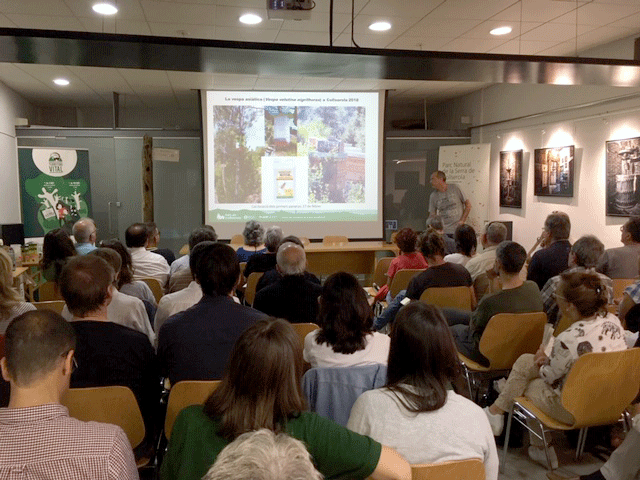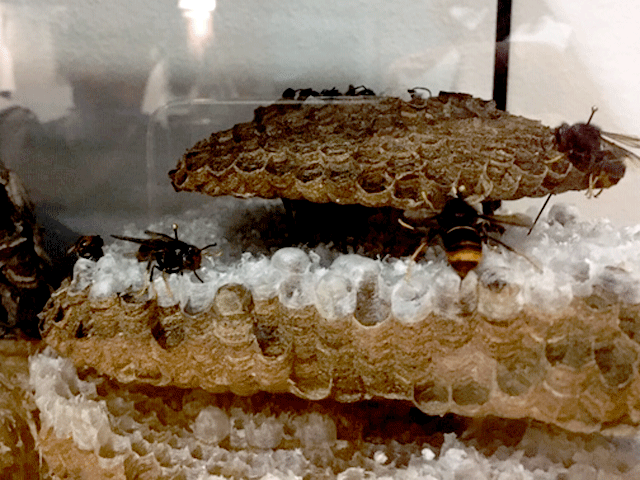The quick invasion of the Asiatic hornet in Collserola Nature Park, Spain
Vespa velutina
An alien invasive species
In Europe, the Asiatic hornet also known as giant killer hornet, Vespa velutina, is an invasive exotic species that is creating great alarm among honey producers for its brutal attacks to bees and the consequences it has in honey productive sector. It first arrived to Bordeaux (France) from Xangai (China) in 2004 and since then it is spreading exponentially and has already been detected in Portugal, Spain, Germany and the United Kingdom.
As an exotic invasive species, Asiatic hornet alters biodiversity: it predates on bees and other insects to obtain protein to feed their larvae and competes with autochthonous hornets and wasps. It also affects economic activities such as apiculture and agriculture. Hornets feed on fruits, ruining the crops, to obtain glucose for themselves. Moreover, it is a risk for people who are allergic to their venom.

Meeting at Collserola for the Management of “Vespa velutina” – Photo by EUROPARC Federation
Chronology of an invasion
In 2017 a single individual of Asiatic hornet was detected in Collserola Nature Park. After that, the park authority quickly stablished a prompt detection and monitoring system to assess the spreading of this alien species. In September 2018, less than one year later, over 1000 Asiatic hornets have been captured in only four months in Collserola. This has rose high concerns among the local popullation, since there are several beehives scattered in the park for honey production and vineyards for wine production that have been badly affected, with half of the production ruined in the present year.
On September 27th the park authority organised a first working meeting in order to coordinate and define a common line of work with the different municipalities of the park, who in fact are the ones to deter the competence to act against this exotic species.
Measures taken at Collserola Nature Park
Jaume Cambra Sánchez, Professor at the University of Barcelona, described the biology of the species and its vital cycle which includes the construction of two nests. A primary nest in spring that is small and round shaped and that contains few workers, and a secondary one, much bigger and with horizontal stripes and a lateral hole that is built durig the summer by the workers and that can host more than 2000 individuals. He also higlighted the importance of follow only trustworthy sources of information, as there is a lot of senstaionalism and hearsay around this species after the decesase of several persons in the Iberian Peninsula since its arrival. For instances, he clarified that the Asiatic hornet, so called killer hornet, inoculates the same amount of venom than any other common wasp in this region, its venom has the same power than in other common wasps and only those persons that show high sensibility or allergies to it can suffer more serious consequences.
“The Asiatic hornet is not more dangerous than any other common hornet found in this region; it inoculates the same amount of venom and with the same power than its relatives”
Josep Maria Olmo, technician from the Catalan government, explained that in the last 2 years there has been a boom of exotic species. It is a global problem. Administration does not act on all alien species, only on those who are really invasive. Regarding the Asian hornet, beekeepers have been the first to present a claim to the Administration in order to tackle the problem. However, the Asiatic hornet is extremely difficult to eradicate. Among the measures put in place by the local administration, taking out or destroying their nests is the prefered one, but this is a partial solution that paliates its spread but does not sort the problem.

Exhibit of Asiatic hornet nest and individuals – Photo by EUROPARC Federation
Emili Bassols, technician from la Garrotxa Natural Park, stated that we will need to learn how to live together with the Asiatic hornet. He describes the process of how they have lived in his park the arrival of the Asian horne, with media causing a general alarm among the population and, a baseline of entomological ignorance shared among the inhabitants and the proliferation of housemade and uncontrolled traps, which can be more detrimental for the environment than benefitial.
“We need to learn how to coexist with the Asiatic hornet, as it has come to stay”
Marta Miralles, technician from Sant Celoni municipality, gave her experience as a representative of a local administration that has had to assume the control of the Asiatic hornet, especially with regards of health and safety towards the population. She also explained the control measures that the municipality has put in place and the responsibilities that the citizenship have to take to be able to control its expansion.
Lastly, the private company Bionet reviewed the different methodologies currently employed to remove the nests, and spoke about their experience with this species.
For further information, contact Teresa Pastor t.pastor@europarc.org